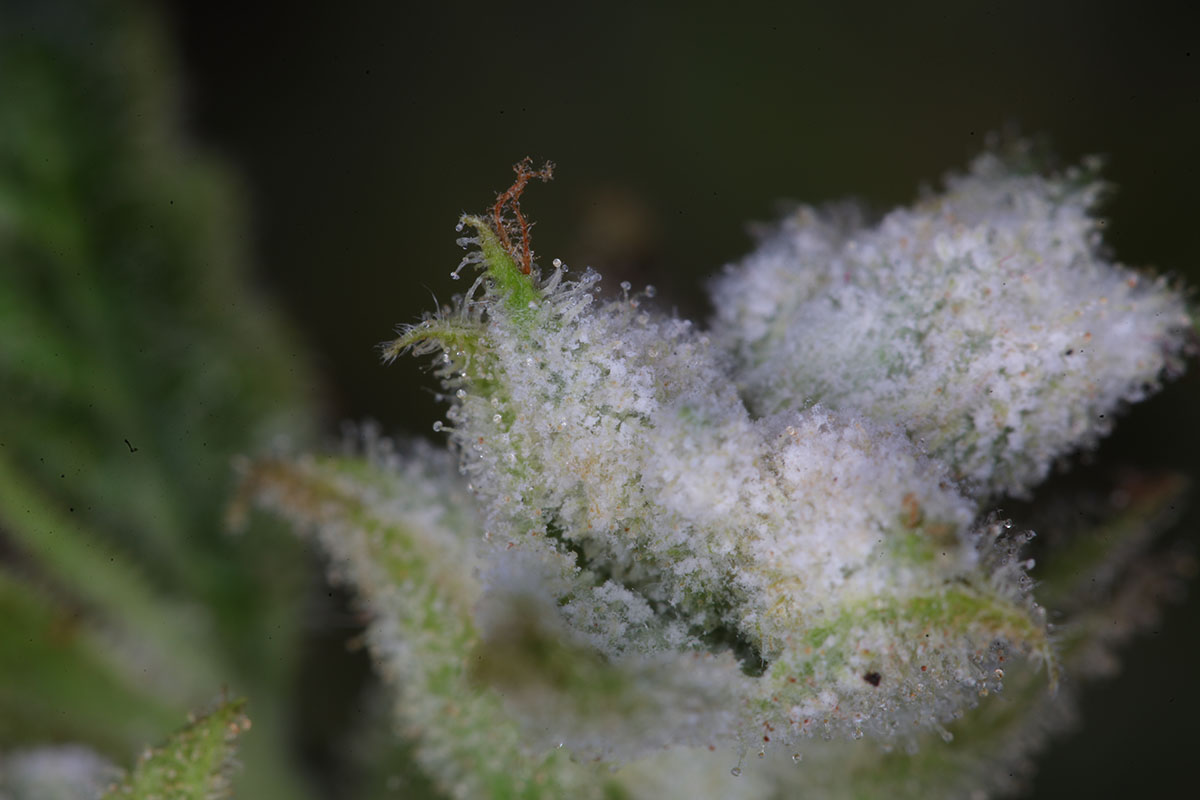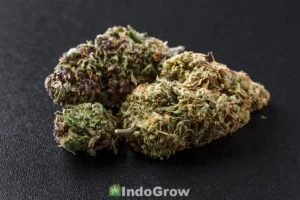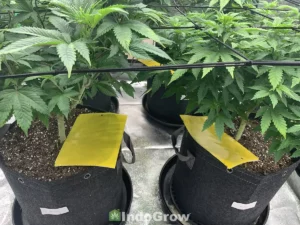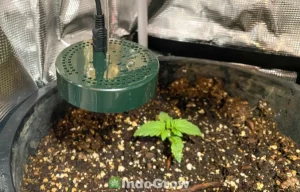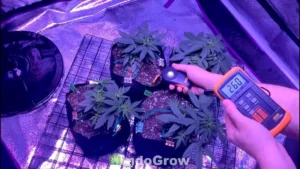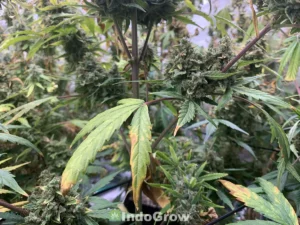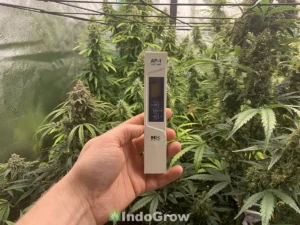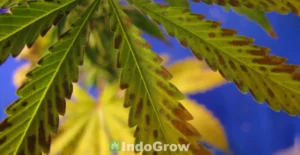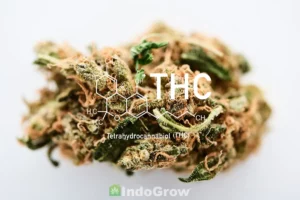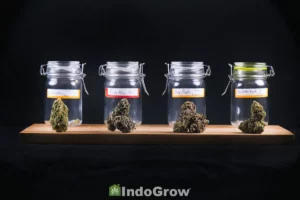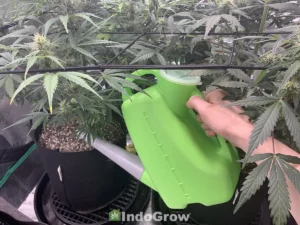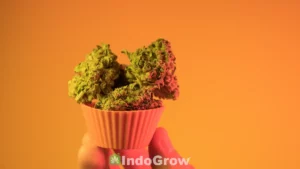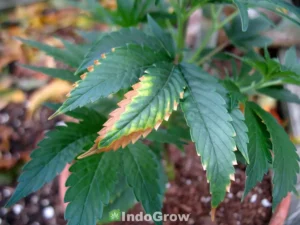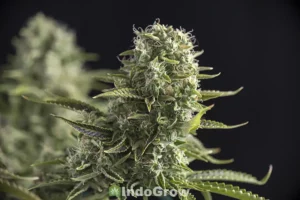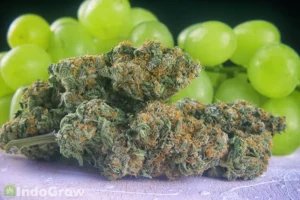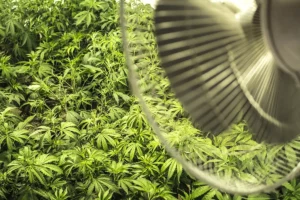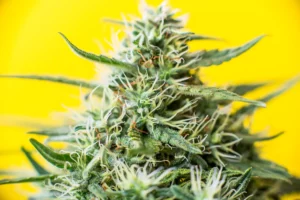Discovering mold on your cannabis plant can spell disaster for your crop, especially if the mold is left untreated and allowed to spread throughout the grow area. Mold can attack at any life stage of the plant, from vegetative to flowering and beyond. It may affect the roots, leaves, or flowers of the cannabis plant.
In order to protect your plants, you must first learn the symptoms of different mold infections, as well as the preventative measures used to stop mold from developing. Careful monitoring of your weed plants and their growing conditions will help ensure a bountiful, mold free harvest.
Table of Contents
Common Types of Mold on Weed
Many types of mold can potentially grow on a cannabis plant. Some molds, like powdery mildew and septoria, primarily affect the leaves. Others, like botrytis or root rot, affect the buds or roots. Below is an overview of some of the most common types of mold found on weed plants.
Powdery Mildew
Powdery mildew is a common type of mold which causes a powdery white buildup on the upper surface of the fan leaves. It typically attacks older, lower leaves first, and may additionally cause wilting and discoloration on affected leaves. If left untreated, powdery mildew will slow the growth of your plant, and may eventually kill it entirely.
Unlike other molds, powdery mildew does not need extended periods of high humidity to thrive. Instead, a humidity fluctuation of just a few hours, often caused by a dip in temperature raising the relative humidity, will provide the moisture needed for spores to germinate. Keeping your weed at a consistent temperature and humidity level is the most effective preventative measure to stop powdery mildew from taking hold.
Botrytis (Gray Mold)
Botrytis, or gray mold, is a necrotrophic fungus that can infect many crops, including grapes, tomatoes, roses, cannabis, and more. Botrytis thrives anywhere high humidity is found. If your cannabis plants are allowed to become so humid that drops of water are forming on them, they are at high risk for a botrytis infection. Botrytis most commonly grows inside of cannabis buds during the later flowering phase, although it can infect any part of the plant besides the roots if conditions are right.
Once botrytis becomes visible, it is too late to save the infected buds. Additionally, the release of spores makes it highly likely that nearby plants will become infected in a densely populated grow room. Therefore, preventing botrytis by keeping humidity low and not watering the plants overhead while flowering is essential.
Septoria Lycopersici
Septoria Lycopersici is a fungus that infects the leaves of certain crops including tomatoes, potatoes, and cannabis. The fungus first enters the plant through the soil, then causes characteristic brown spots to appear on the lower leaves of the plant. If left untreated, the leaf spots will increase in size, eventually killing the infected leaves and weakening the plant.
Septoria infections often occur due to overwatering or overcrowding plants, combined with the use of infected soil or other growing materials that harbor Septoria spores. Removing leaves that are touching the soil or other plants, and increasing soil level air circulation are good preventative measures.
What is Bud Rot?
Bud rot is the most common presentation of the botrytis fungus in cannabis plants. It starts in the center of the bud and works outward, eventually causing dusty gray mold spores to appear on the outside of the bud. The entire bud will eventually become dark and soft as the rot progresses.
Bud rot is most common on plants with large, dense buds, especially indicas. Keeping your plants in a well ventilated room with good airflow and humidity of 60% or lower during the flowering and drying phases will help prevent bud rot. Buds infected with botrytis are unfit for consumption and should be removed as soon as the rot is detected.
What is Leaf Septoria?
Leaf septoria, also called yellow leaf spot, is an infection of the Septoria Lycopersici fungus in cannabis plants. It begins as tiny brown or yellow spots, usually on the lower, older fan leaves of the cannabis plant. The spots slowly increase in size and combine, eventually killing off the leaf.
Leaf septoria typically affects plants in the early stages of flowering, and the stress of the infection can greatly decrease the size and quality of your buds. If caught early, infected leaves can be trimmed away with a sanitized pruning shears or scissors. However, if the infection has spread to the leaves closest to the flowers, removing all the infected leaves may stress the plant more than just leaving them.
Improving air circulation, avoiding overhead watering, and removing any dead foliage on or around the plants is the most effective way to both prevent and treat leaf septoria.
What is Root Rot?
Root rot is any fungal or bacterial that attacks the roots of cannabis plants. Affected plants can show a variety of symptoms above the soil, but the only way to diagnose root rot is to inspect the roots. Healthy roots will be plump, firm and white, while rotten roots will be brown, slimy, and soft.
Root rot reduces the plants ability to take in water, oxygen, and other essential nutrients. The plant’s leaves will wilt and fall off as the roots decay, eventually killing the plant. Root rot can happen in both soil and soilless systems, and is typically caused by overwatering or lack of oxygen to the roots.
To prevent root rot, ensure that your soil is not too dense, and the soil is allowed to dry out between waterings. In hydroponics systems, water that is too warm, contains dead leaves or other decaying matter, or is stagnant and lacking in oxygen may cause root rot to take hold. To attempt to save the plant, affected roots should be trimmed away, and growing conditions should be corrected.
How to Identify Mold on Weed
Mold can present in a variety of forms, including white or gray powder on the leaves or buds, slimy, rotten roots or stems, and brown or yellow spots on the leaves. Large, dense buds are especially susceptible to mold. It is important to check your buds regularly to make sure they are not becoming soft or discolored.
After harvest, buds can still become infected with mold during the drying and curing stages. An ammonia like smell is one of the earliest signs that curing buds have become infected with a fungus or bacteria. Buds with a chemical smell or visible mold should be discarded immediately, since they are no longer safe to smoke or otherwise consume.
How to Prevent Mold on Weed Plants?
Once mold appears on your cannabis plant, it can be highly damaging and difficult to treat. Because of this, proper prevention is the best way to protect your crop from mold.
To prevent mold, your grow room should be kept between 75-85 F, with temps slightly lower at night when the lights are off. Humidity should be kept between 50-60% during the vegetative stage, and lowered to 40-50% during flowering when the plant is most vulnerable to mold. Adding a dehumidifier can be helpful, especially during the flowering stage.
Proper ventilation is essential to keep pockets of hot, wet air from developing. Your grow room should include an exhaust fan with a carbon filter, as well as at least two oscillating fans: one pointed at the soil and another pointed at the crowns. Trimming the foliage closest to the soil can also help increase air flow around the plants.
How to Prevent Mold When Curing and Storing Buds?
Mold can also develop while curing and storing buds. After drying, buds should be stored in sealed glass containers with humidity packs to keep their humidity around 60%. The glass jars should be opened, or ‘burped’, daily to release built up CO2 and let in fresh air.
Botrytis or harmful bacteria can proliferate on buds kept in humid, stale air. Symptoms may include dusty gray mold, ammonia smells, and softening and discoloration of the buds. Storing buds in the freezer can also damage their structure and make them far more susceptible to molding when unthawed.
How to Get Rid of Mold on Weed?
Most plants that have been infected with mold cannot be saved, especially if mold is present on the buds. These plants should be removed and destroyed away from your other plants, and any clothes and tools that came in contact with them should be sanitized to remove mold spores. Similarly, buds that become moldy while curing cannot be saved and should be disposed of away from all other cannabis to prevent further infection.
If only the leaves of a flowering plant are affected, such as with powdery mildew or leaf septoria, treatment may be appropriate. Trim off and dispose of infected leaves if possible, then treat the remaining leaves with neem oil or another safe fungicide of your choice. Never use chemicals on or near the buds.
Improving the ventilation and humidity of your plants can also slow the spread of the mold and buy you more time until your harvest is ready. However, good prevention is the only way to truly stop mold from taking over your plant.
Summary
Mold is a common problem for weed plants, and can attack any part of the plant from the roots to the buds. Mold can appear as a white or gray powder on the leaves or flowers, brown soggy roots, spotted leaves, and more. Most plants cannot be saved from a fungal infection, so proper prevention is crucial to protecting your cannabis plants from mold.
Mold proliferates in hot, wet places. Good air circulation, stable temperatures, and humidity below 60% are important parameters to protect your growing plants from mold. Ensure that your plants have enough space for air to move between them and below them. To protect the plant’s roots, use a growing medium with good aeration, and allow the plant to dry out partially between waterings.
Once the buds are harvested, they are still at risk of bud rot, a common type of fungal infection. Buds should be air dried, then moved to sealed glass containers to cure. During curing, humidity should remain around 60% and the jars should be open daily to allow for air exchange. Discard any buds that smell like ammonia or have visible mold.
The best way to prevent mold is provide adequate ventilation for your cannabis plants. To learn more, check out Grow Tent Ventilation.

Rocky Horton
Author
Rocky Horton is an experienced cannabis grower and the founder of IndoGrow. The IndoGrow editorial team has over four decades of combined growing experience. Learn more.

